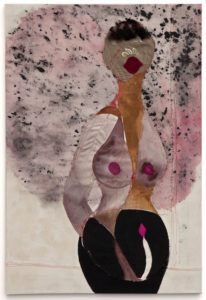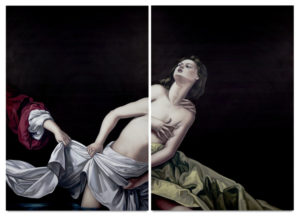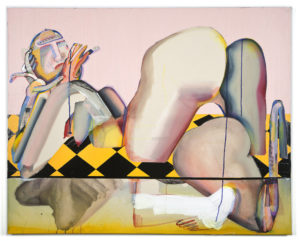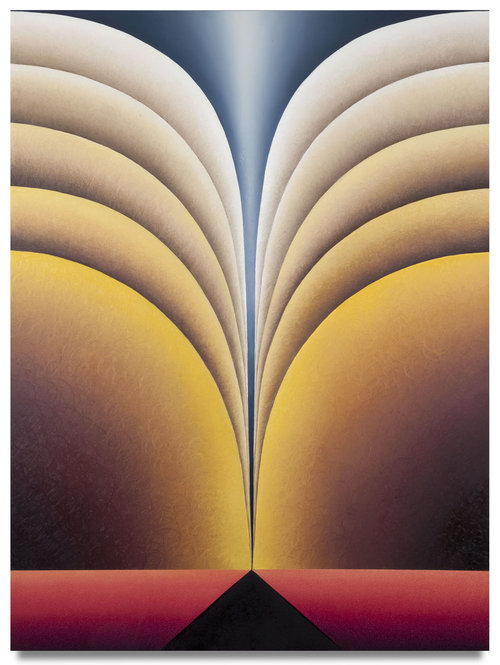What are the contours of gender? Is there a range of conditions that determine gender along a curve or spectrum we can visualize or somehow represent, measure or analyze? Is there a focal point we can identify that will turn it in one direction or another? Most of us are aware of the inflectional aspects of gender – in both a literal grammatical sense, and a larger physical or behavioral dimension of attitude, perception and response. Then, too, there is the aspect of voice – in a range of senses that extend from the physical, acoustical and anatomic, each with its corresponding resonance and frequency, to the cerebral vibrations of consciousness itself, that proto-conceptual engine which assembles, composes, and ‘engenders’ identity – the ‘feedback’ mechanisms that check sensory input against the expected, the predicted; the ‘interior voice’ that gives rise to projection and expression (and perhaps ultimately ‘style’).
Then there is the highly variable (yet frequently rigid) cultural frame, and the array of signs and signals (themselves no doubt bearing some correspondence to the neuro-chemistry and electricity that are the template for this aspect of the conscious mind) which continuously press upon these contours, pushing them to revise, refine, ‘re-state.’ Or possibly to suppress some aspect of this ultimately externalized, ‘engendered’ identity. There are ‘defense’ mechanisms built into these structures. Is there a dynamic topology we can apply to these multi-faceted, multi-valent systems?
I’ll get to sex in a minute.
 The conversation around gender and identity has shifted somewhat over the last several years, driven both by culture and politics, also technology in no small part. The conversation – and the vocabulary for that conversation – have always been there. We are simply increasingly free to engage and share it with a larger public (across gender, sexual, social/cultural and ideological spectrums) that is curious and receptive and who are themselves capable of contributing and enriching it. Moreover it has always been the largest, most far-reaching conversation for the simple reason that it encompasses a range of theoretical and practical discussions from the microcosmic and purely phenomenological to the kinds of macrocosmic cultural discussions that are suddenly playing out everywhere. It’s embedded in the way we talk and the way we walk.
The conversation around gender and identity has shifted somewhat over the last several years, driven both by culture and politics, also technology in no small part. The conversation – and the vocabulary for that conversation – have always been there. We are simply increasingly free to engage and share it with a larger public (across gender, sexual, social/cultural and ideological spectrums) that is curious and receptive and who are themselves capable of contributing and enriching it. Moreover it has always been the largest, most far-reaching conversation for the simple reason that it encompasses a range of theoretical and practical discussions from the microcosmic and purely phenomenological to the kinds of macrocosmic cultural discussions that are suddenly playing out everywhere. It’s embedded in the way we talk and the way we walk.
 And then there’s the sex – which may be complicated – or not. Or not there at all. It’s a lens that puts gender issues into another kind of focus, opening up additional possibilities for self-discovery. (It is relational, after all.) This may simply be another level of desire, a sexual tweak or an avenue of pleasure, but it all informs the sense of personal drives marking that part of identity we occasionally call character. We’re usually never more sure or less sure of ourselves in these situations and there may be any number of opportunities to redefine some aspect of the identity (gender, sexual and otherwise) at play in them. A certain amount of social decoding can be accelerated in such radically equalizing conditions – though, relational factors notwithstanding, there are no guaranties. We wear masks – the better to play the role that may or may not intersect with the pleasure-seeker beneath, but may well inform the one we play/are next.
And then there’s the sex – which may be complicated – or not. Or not there at all. It’s a lens that puts gender issues into another kind of focus, opening up additional possibilities for self-discovery. (It is relational, after all.) This may simply be another level of desire, a sexual tweak or an avenue of pleasure, but it all informs the sense of personal drives marking that part of identity we occasionally call character. We’re usually never more sure or less sure of ourselves in these situations and there may be any number of opportunities to redefine some aspect of the identity (gender, sexual and otherwise) at play in them. A certain amount of social decoding can be accelerated in such radically equalizing conditions – though, relational factors notwithstanding, there are no guaranties. We wear masks – the better to play the role that may or may not intersect with the pleasure-seeker beneath, but may well inform the one we play/are next.
It’s a ‘generative’ phenomenon – as curator Joshua Friedman references in a brief prospectus for this group exhibition curated for the Kohn Gallery. Friedman uses the term in a temporal context – as in generated or ‘engendered anew’ over time in a ‘conversation’ (of both materials and styles) that reference and reach back through history and through historical styles and sources as well as contemporary experience. But it’s applicable to that larger conversation we’re having beyond the precincts of the fine arts as experienced in galleries and museums. It reflects a more fluid, conditional and expansive approach and discussion of gender and identity more broadly, even consciousness itself.
It shouldn’t be surprising that a show like this ranges from a quasi-symbolist approach (Gauguin is practically quoted by one of the artists), through a sweeping historic/stylistic swath to the surreal and fantasist, to the quasi-allegorical (or in this instance a kind of selected, interrupted allegory), to the fluidly Pop, to abstraction both cool and heatedly expressive as well as slightly deconstructed, to the cartoonish and self-consciously pastiched. To paraphrase a seminal Sontag essay, we need both an erotics and a hermeneutics of gender and identity; and I think both methodologies are available here.
It might be hard to see where Nicole Eisenman’s Cat (2014) fits into this mix – the intention may be simply to tease or disarm – but it does get at something we see more and more – fueled by social media and certainly the twittersphere – which is the popularity of the avatar, the mask; not infrequently the pet as alter-ego. ‘The cat (dog, etc.) is father to the man (or woman).’ There are a lot of us who might relate to this (though I’ll note for the record that my cat, Smoky, remains the child in our relationship). She sort of leaps over the gender issue straight to identity in a slightly cartoonish horror-fantasy vein with her Were-Artist (executed earlier in 2007), but this, too, bears on a very contemporary and concrete metamorphosis. The show begins in earnest with Loie Hollowell’s Yellow Mountains (2016) which refines an almost schematic landscape into a kind of Purist distillation of the kind of broadly sexualized and symbolic landscapes O’Keefe made famous out of the American southwest. The effect is both symbolic and erotic – in other words, its own kind of avatar – and brilliantly executed.
Emily Mae Smith also approaches the quasi-symbolic avatar in her deliberately slickened, novelty/advertising-influenced imagery – except that there’s something more going on that creeps into a narrative and quasi-allegorical vein. The details are strikingly specific and articulated. Consider the cut-away lip from the candle (or fuse?) in The Caress study I (2017) or the four-pronged hook or gaff that descends from its pear-shaped perimeter into an aqueous space that might also resemble an anatomical contour in Abyss (2017) – with this liquid sensual center flanked heraldically by matching mermaids – a nautical coat of arms? (‘Bolts’ are thoughtfully included should we wish to attach this insignia to, say, the prow of a boat.)
 Then there is the ‘interrupted’, discontinuous (oil on canvas diptych) allegory of Jesse Mockrin. Mockrin’s technique and style have been compared to the Rococo style of Fragonard (and certainly there’s more than a hint of Boucher here), but here it’s much closer to a kind of sci-fi twilight spin on the very late Baroque – after Caravaggio and approaching something closer to, say, Bronzino (e.g., the Bronzino of Venus, Cupid, Folly and Time (1545) hanging in London’s National Gallery). Actually it’s astonishingly close to this sort of late Mannerist allegory, though with the complex tangle of Bronzino’s souffle de coeur blanketed in velvety pitch-darkness (the stuff of the allegory itself – the gods and their supporting spirits clearly up to grave mischief – we scarcely need to know more), returning our focus to the events immediately before us – staggered, if not entirely discontinuous here. Mockrin both brings the quasi-Mannerist allegory up to date with a cinematic twist, and introduces ambiguities that bring it in closer accord with the spirit of the Wallace Stevens poem that inspires it, rather than the biblical tale of Susanna it references (a subject that has itself been the subject of innumerable paintings since the Italian Renaissance) – really an announcement of lust and its blood roar of neuro-chemical stimulation. (Mockrin’s title is A cymbal crashed, and roaring horns – taken from Stevens’ “Peter Quince at the Clavier.”) Yet the cool palette and and finish of the canvas tamps down the slightly febrile quality of the Stevens verse. There’s a coolness (as in so many of Bronzino’s own works) that belies the anticipated violation. The hand grasping the drapery in the left canvas is certainly not a male ‘elder’s’, whereas our only slightly androgynous ‘Susanna’ may not be a ‘Susanna’ at all – though the hands at his/her chest and shoulder in the right canvas might well be female. The drapery covering the lower torso has also changed. Violation here encroaches softly, even tenderly here, moving away from the ‘crash and roar’ of a brass choir to ‘concealed imaginings,’ and conceivably further ahead to ‘Death’s ironic scraping.’
Then there is the ‘interrupted’, discontinuous (oil on canvas diptych) allegory of Jesse Mockrin. Mockrin’s technique and style have been compared to the Rococo style of Fragonard (and certainly there’s more than a hint of Boucher here), but here it’s much closer to a kind of sci-fi twilight spin on the very late Baroque – after Caravaggio and approaching something closer to, say, Bronzino (e.g., the Bronzino of Venus, Cupid, Folly and Time (1545) hanging in London’s National Gallery). Actually it’s astonishingly close to this sort of late Mannerist allegory, though with the complex tangle of Bronzino’s souffle de coeur blanketed in velvety pitch-darkness (the stuff of the allegory itself – the gods and their supporting spirits clearly up to grave mischief – we scarcely need to know more), returning our focus to the events immediately before us – staggered, if not entirely discontinuous here. Mockrin both brings the quasi-Mannerist allegory up to date with a cinematic twist, and introduces ambiguities that bring it in closer accord with the spirit of the Wallace Stevens poem that inspires it, rather than the biblical tale of Susanna it references (a subject that has itself been the subject of innumerable paintings since the Italian Renaissance) – really an announcement of lust and its blood roar of neuro-chemical stimulation. (Mockrin’s title is A cymbal crashed, and roaring horns – taken from Stevens’ “Peter Quince at the Clavier.”) Yet the cool palette and and finish of the canvas tamps down the slightly febrile quality of the Stevens verse. There’s a coolness (as in so many of Bronzino’s own works) that belies the anticipated violation. The hand grasping the drapery in the left canvas is certainly not a male ‘elder’s’, whereas our only slightly androgynous ‘Susanna’ may not be a ‘Susanna’ at all – though the hands at his/her chest and shoulder in the right canvas might well be female. The drapery covering the lower torso has also changed. Violation here encroaches softly, even tenderly here, moving away from the ‘crash and roar’ of a brass choir to ‘concealed imaginings,’ and conceivably further ahead to ‘Death’s ironic scraping.’
What ‘sighs’ there might be here are swallowed by the black vacuum; yet Mockrin’s melody plays on. According to the gallery’s notes, Jansson Stegner is also influenced by ‘Old Masters’, but his well-muscled Julie here (2017) is closer to a Pop-inflected surrealism. Here, too, there’s a sci-fi note in that it won’t be very long before parents will be capable of customizing their offspring to be girls who not only ‘bend it like Beckham’ but have the best parts of his physique. But we’ve seen these upper arms before: they belong to Serena Williams.
Hernan Bas’ ‘boys’ are probably the boys he intends to depict here, but both specimens are clearly in a reverie that could take them – and the paintings themselves – in any direction. Bas has been known to reference popular gay tropes such as 19th century English Aesthetes, the English public schools, and the international diaspora of young (usually gay) men of pleasure – but the paintings here move in a distinctly abstract direction. I’m not sure if an ‘engendering’ is implied by titling one of them The pink neurosis, but certainly the subject can easily accommodate both chromatic and behavioral dimensions (and probably both simultaneously – Schiaparelli would have thought so). Bas’s tempest-tossed ribbons of pigment struck a kind of triangulation with Firelei Baez’s glowing tangle of motley-colored/patterned limbs in their hustling conga line and Tschabalala Self’s gorgeous mixed-media peacock carrying a candle, if not a ‘torch’, for a presumably equally flamboyant match.
 A show like this one – always in motion, always in a state of becoming – will inevitably have one or more ‘still centers’ that suggest a kind of equilibrium or at least a conditional rest. Friedman’s is no exception. Eisenman’s aforemtioned Cat is one such place. Zoë Charlton’s stolid handmaidens of Cotton are another. Jennifer Packer’s Untitled study of a reclining boy – seemingly radioactive in its flaming reds, fuscia, purple-red and cerise – is another — a sinkhole of a painting that pulls the viewer down to its subject and into a kind of bottomless pool of pigmented persona. Mehquitta Ahuja’s odalisque has an element of this stillness, but in pursuit of something quite distant from this particular kind of ‘conditional’. Nathaniel Mary Quinn’s Chad (2017), on the other hand is that center: an identity being born, assembled (and torn apart), and opening its eyes; floating tentatively between masks, actuality and essence; entirely vulnerable, available, receptive, innocent – in its open commitment to the moment. (It could be the face of a ‘folly’ missing from Mockrin’s broken allegory.) No pink, red, black, or white – the entire spectrum is here.
A show like this one – always in motion, always in a state of becoming – will inevitably have one or more ‘still centers’ that suggest a kind of equilibrium or at least a conditional rest. Friedman’s is no exception. Eisenman’s aforemtioned Cat is one such place. Zoë Charlton’s stolid handmaidens of Cotton are another. Jennifer Packer’s Untitled study of a reclining boy – seemingly radioactive in its flaming reds, fuscia, purple-red and cerise – is another — a sinkhole of a painting that pulls the viewer down to its subject and into a kind of bottomless pool of pigmented persona. Mehquitta Ahuja’s odalisque has an element of this stillness, but in pursuit of something quite distant from this particular kind of ‘conditional’. Nathaniel Mary Quinn’s Chad (2017), on the other hand is that center: an identity being born, assembled (and torn apart), and opening its eyes; floating tentatively between masks, actuality and essence; entirely vulnerable, available, receptive, innocent – in its open commitment to the moment. (It could be the face of a ‘folly’ missing from Mockrin’s broken allegory.) No pink, red, black, or white – the entire spectrum is here.
Natalie Frank’s Tyler (2017) is a straightforward, almost traditional portrait of a gender-fluid subject now readily accessible in mass culture. Yet there is a tension between the highlighted, more articulated features (eyes shining from their made-up aura, lipstick-stained mouth, budding breasts) and the coy pale pink drapery and blue atmospheric swirl she paints around her subject. On one hand, this could simply be a drag artist seated in his make-up chair; on the other, it responds obliquely to the image of the figure in transition increasingly visible in recent years. We’re becoming accustomed to seeing individual identities, both factual and fictional, under construction or re-construction. What is not usually shown is the deconstruction, actual and psychological, that is usually taking place simultaneously. And although for example, a certain range of ‘trans-identity’ is now available in mass culture (e.g., television – Orange Is the New Black, Glee, Dirty Sexy Money, Transparent; or film – A Fantastic Woman), the viewer has to piece together a theory of each specific de- and reconstruction situationally according to the story-line and the characters’ dramatic interaction with other characters – who usually have their own layered stories and character trajectories.
The pathos of the subject is expressed in the hands, faintly outlined in blue, cupped as if in a traditional 16th or 17th century portrait. It could be the anti-Gioconda – La Triste,or perhaps simply L’Attesa – his/her hands cupped into a bowl that might receive her – a wait that can take a lifetime.
Jonathan Lyndon Chase’s exuberantly graphic paintings have a simlar pathos, but more directly stated. The subjects (mostly male, but not unambiguously) are variously inverted (as in Pulpit (1), 2016 – the subject sheds tears) or extroverted (though mostly the latter), but always engaged transactionally – insistent, even defiant. The titles read like the artist commenting to his own creations – e.g., Slow Down (2017) or 2 bottoms (2016). Yes, damnit – queer, bottom and loving it.
Mequitta Ahuja’s Fingering Vanitas (2015) is that ‘Gauguin’ moment I mentioned above – but with a difference stated in the handling of the paint (which looks almost scraped on like pastry), the subject’s disconcern, absently fingering her flowers, and the contrast of the severely imposed rhomboid geometry of the structural surround – zones of enclosure. It couldn’t be further removed from Sadie Laska’s wildly colored and bisected masculine-feminine figure (though with the feminine dominant – Untitled, 2017) – a kind of Condo-Basquiat-De Kooning mash-up of gesture gone very rogue and very wild. Which in turn is a world away from the entanglements encountered in Christina Quarles’ masterpieces of surreal and erotic abstraction. I’ll quote the title of Heidi Hahn’s color abstraction cartoonish vignettes – it’s The Same Story Told Backwards. Quarles’ paintings deserve a post of their own.
If I’m giving the impression here that every painting in this show commends attention – well, it’s because they do. There is a reason why Friedman has chosen to freely commingle realism with abstraction, historicism with the contemporary, the symbolic and surreal with the brutally expressive and gestural. This is a conversation that demands and consumes every conceivable viewpoint. No synthesis is possible in such a conversation, any more than the synthesis of identity is ever really entirely settled or stable. We, along with our ideas of ourselves and those around us, are always in flux. The engendering, like consciousness itself, is a continuity – not necessarily expanding indefinitely, but in a kind of infinite exchange. Engendering marks a moment of definition before the next beginning.


